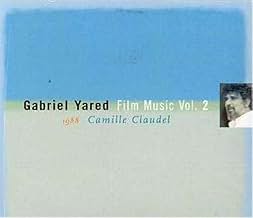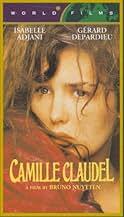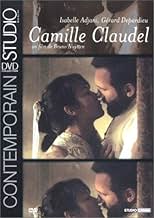AVALIAÇÃO DA IMDb
7,3/10
7,8 mil
SUA AVALIAÇÃO
Camille Claude impressiona o já famoso escultor Auguste Rodin. Ele a contrata como sua assistente, mas logo Camille começa a esculpir-se e também se torna sua amante. Mas depois de um tempo,... Ler tudoCamille Claude impressiona o já famoso escultor Auguste Rodin. Ele a contrata como sua assistente, mas logo Camille começa a esculpir-se e também se torna sua amante. Mas depois de um tempo, ela gostaria de sair da sombra dele.Camille Claude impressiona o já famoso escultor Auguste Rodin. Ele a contrata como sua assistente, mas logo Camille começa a esculpir-se e também se torna sua amante. Mas depois de um tempo, ela gostaria de sair da sombra dele.
- Direção
- Roteiristas
- Artistas
- Indicado a 2 Oscars
- 7 vitórias e 14 indicações no total
Avaliações em destaque
I couldn't take my eyes away from the television, and it wasn't because it was in French with English subtitles. This is a superbly acted film depicting two artists' work, passion, fears and ultimately her downfall, falling victim to her own creative mind.
Now that this wonderful story will be a Broadway musical in 2003 under the finesse of Frank Wildhorn and the magical voice of lovely Linda Eder, one will certainly appreciate familiarizing themselves with the background of the subject of this movie, Camille Claudel.
Now that this wonderful story will be a Broadway musical in 2003 under the finesse of Frank Wildhorn and the magical voice of lovely Linda Eder, one will certainly appreciate familiarizing themselves with the background of the subject of this movie, Camille Claudel.
This film is about the tragic failure of a genius. She fails not so much because of her tendency to make fatal mistakes but because of the shape those mistakes took in her mind. This, even as lesser personages prospered (e.g., Camille's brother Paul, the famous Catholic poet and diplomat) because they were not adverse to espousing convenient "beliefs" for the sake of earthly success. Many viewers will feel a strong affinity with Camille, not because they consider themselves geniuses but rather for the interior world she constructed that, without religion, gave the exterior world meaning. I say she was without religion, but in fact sculpture was her religion--at least until her final failure to gain the respect and patronage of capricious buyers. It was then that her religion (her meaningful myth) took the form of a conspiracy delusion. Powerful people, she thought (mostly, the sculptor Rodin, who had been her lover), were out to get her, thwarting her every move.
What we experience here is a thoughtful, scary exploration of the darkness that is a paradoxical part of all brilliance.
What we experience here is a thoughtful, scary exploration of the darkness that is a paradoxical part of all brilliance.
10Banquo13
Isabelle Adjani is stunning as the title character in this rich and passionate film. I am amazed anytime an actor or actresses changes physically in the part of a film (and without tons of make-up and special effects, either!)and Adjani does this remarkably well! We as an audience are just as stunned as Eugene Blot when he finds Camille drunk and spiraling into the depths of madness. Her appearance is nothing less than shocking.
The film as a whole is engaging with a whirlwind of emotions--rage, sadness, torment, bliss; by the time the nearly 3 hours are up, I am exhausted. Adjani and Depardieu are part of that emotional energy as they passionately go at it--sex, sculpture and anger; especially when it comes to the latter. It is almost worth it to stop reading the subtitles and listen to them rage and lash out at one another.
Adjani is powerful in so much of this film...I am amazed she didn't receive that best actress Oscar she was up for. Her torment and pain is riveting--especially in French. I am glad they did not decide to dub this film into English; hearing Adjani sob and ask "Pourquoi? Pourquoi?" would be empty with her mouthing the words "Why? why?" in English.
The film as a whole is a bit long, but overall is stunning. The sad epilogue is even sadder if you know that Claudel's remains were interred in a mass grave after her brother Paul failed to claim them from her original grave [the asylums only interred bodies in individual plots for a certain amount of time; space was at a premium.] So, the brilliant Camille Claudel's remains ended up in an unmarked grave mixed in with others who went unclaimed, as well.
The film as a whole is engaging with a whirlwind of emotions--rage, sadness, torment, bliss; by the time the nearly 3 hours are up, I am exhausted. Adjani and Depardieu are part of that emotional energy as they passionately go at it--sex, sculpture and anger; especially when it comes to the latter. It is almost worth it to stop reading the subtitles and listen to them rage and lash out at one another.
Adjani is powerful in so much of this film...I am amazed she didn't receive that best actress Oscar she was up for. Her torment and pain is riveting--especially in French. I am glad they did not decide to dub this film into English; hearing Adjani sob and ask "Pourquoi? Pourquoi?" would be empty with her mouthing the words "Why? why?" in English.
The film as a whole is a bit long, but overall is stunning. The sad epilogue is even sadder if you know that Claudel's remains were interred in a mass grave after her brother Paul failed to claim them from her original grave [the asylums only interred bodies in individual plots for a certain amount of time; space was at a premium.] So, the brilliant Camille Claudel's remains ended up in an unmarked grave mixed in with others who went unclaimed, as well.
There's some nice photography in here, which is what helped me get through this long (159 minutes) soap opera-type story about the girlfriend (the title name, played by Isabelle Adjani) of the famous sculptor Rodin (Gerard Depardieu).
There are a lot of closeups of Adjani which was fine with me as I never get tired of seeing her looks. "Camille" also was a sculptor but when the romance with Rodin went sour, she went literally crazy. This movie details that saga.
In addition to the cinematography, you get to see some great sculptures - really good pieces of work. I just wish they had shown how the artists accomplished these pieces. Since they are just actors, all it did was show the two leads chipping away chunks of clay, never showing any detail work.
At least, the film made me appreciate the art form more.
There are a lot of closeups of Adjani which was fine with me as I never get tired of seeing her looks. "Camille" also was a sculptor but when the romance with Rodin went sour, she went literally crazy. This movie details that saga.
In addition to the cinematography, you get to see some great sculptures - really good pieces of work. I just wish they had shown how the artists accomplished these pieces. Since they are just actors, all it did was show the two leads chipping away chunks of clay, never showing any detail work.
At least, the film made me appreciate the art form more.
In the realm of art and cinema, there are tales of triumph, stories of struggle, and then there is the heart-wrenching saga of Camille Claudel, masterfully portrayed in Bruno Nuytten's film. This cinematic masterpiece delves into the life of the 19th-century French sculptor Camille Claudel, bringing her intricate story to life with unparalleled grace and depth. It's a tale of passion, creativity, madness, and societal restraint, told through the lens of Camille's artistry.
Camille Claudel, portrayed by the brilliant Isabelle Adjani, was a remarkable sculptor. The film showcases her life journey, from her upbringing in the small village of Villeneuve-sur-Fère to her artistic blossoming in Paris under the guidance of none other than the renowned Auguste Rodin. Their encounter, a passionate rendezvous between student and master, ignites a profound and turbulent love affair.
The film captures the beauty of Camille's artistry as her hands meticulously shape exquisite works of art. Her sculptures are a testament to her modernity, audacity, and unwavering dedication to the craft. They reflect the struggles, the passions, and the relentless pursuit of her artistry, providing glimpses into her inner world. While Camille's works are captivating, her relationship with Rodin brings both admiration and scorn. Their union is a blend of student-mentor dynamics, artistic collaboration, and intense romantic involvement, leading to unrelenting societal judgment.
Yet, Camille is not solely defined by her artistic genius. Her life is marked by isolation, frustration, and the anguish of an unrequited love, intensified by Rodin's continued relationship with Rose Beuret. She becomes an artist alone, adrift in the sea of her emotions. Her world is a whirlpool of despair, loneliness, and financial struggle, interspersed with visions and obsessions that haunt her.
Camille's family disapproves of her lifestyle and choices, and the art world misunderstands her uniqueness. Her mother despises her perceived recklessness, her brother Paul harbors jealousy for her extraordinary talent, and her sister Louise schemes to claim Camille's inheritance. In the face of relentless adversity, Camille is committed to her artistic expression and personal journey.
Despite her distance from Rodin, he continues to support her with discreet acts of kindness. He writes letters to secure precious materials for her work, and he introduces her to influential art critics. However, these critics view her art as unconventional, mirroring her uniqueness and inner turmoil.
Camille Claudel, the artist par excellence, lived a life of wealth, beauty, determination, and promise in her youth. Still, her brilliance was overshadowed by the tragedy of her later years. She was left unrecognized, locked away in isolation, where her art became both her refuge and her torment. It was here, within the confines of her solitude, that she chose to destroy many of her own creations.
Camille's story is a testament to a life of artistry and heartache, unacknowledged talent, and the agony of unrealized dreams. Her impact on the art world was long overdue for recognition. Almost a century later, in 1988, her life's narrative was finally shared with the world through Bruno Nuytten's film, marking a turning point in the rediscovery of her art and her enduring legacy. The Musée Camille Claudel, opened in 2017 in Nogent-sur-Seine, France, stands as a national museum, dedicated to preserving and celebrating her art, ensuring that Camille Claudel's work rightfully finds its place in the annals of art history.
Camille Claudel, portrayed by the brilliant Isabelle Adjani, was a remarkable sculptor. The film showcases her life journey, from her upbringing in the small village of Villeneuve-sur-Fère to her artistic blossoming in Paris under the guidance of none other than the renowned Auguste Rodin. Their encounter, a passionate rendezvous between student and master, ignites a profound and turbulent love affair.
The film captures the beauty of Camille's artistry as her hands meticulously shape exquisite works of art. Her sculptures are a testament to her modernity, audacity, and unwavering dedication to the craft. They reflect the struggles, the passions, and the relentless pursuit of her artistry, providing glimpses into her inner world. While Camille's works are captivating, her relationship with Rodin brings both admiration and scorn. Their union is a blend of student-mentor dynamics, artistic collaboration, and intense romantic involvement, leading to unrelenting societal judgment.
Yet, Camille is not solely defined by her artistic genius. Her life is marked by isolation, frustration, and the anguish of an unrequited love, intensified by Rodin's continued relationship with Rose Beuret. She becomes an artist alone, adrift in the sea of her emotions. Her world is a whirlpool of despair, loneliness, and financial struggle, interspersed with visions and obsessions that haunt her.
Camille's family disapproves of her lifestyle and choices, and the art world misunderstands her uniqueness. Her mother despises her perceived recklessness, her brother Paul harbors jealousy for her extraordinary talent, and her sister Louise schemes to claim Camille's inheritance. In the face of relentless adversity, Camille is committed to her artistic expression and personal journey.
Despite her distance from Rodin, he continues to support her with discreet acts of kindness. He writes letters to secure precious materials for her work, and he introduces her to influential art critics. However, these critics view her art as unconventional, mirroring her uniqueness and inner turmoil.
Camille Claudel, the artist par excellence, lived a life of wealth, beauty, determination, and promise in her youth. Still, her brilliance was overshadowed by the tragedy of her later years. She was left unrecognized, locked away in isolation, where her art became both her refuge and her torment. It was here, within the confines of her solitude, that she chose to destroy many of her own creations.
Camille's story is a testament to a life of artistry and heartache, unacknowledged talent, and the agony of unrealized dreams. Her impact on the art world was long overdue for recognition. Almost a century later, in 1988, her life's narrative was finally shared with the world through Bruno Nuytten's film, marking a turning point in the rediscovery of her art and her enduring legacy. The Musée Camille Claudel, opened in 2017 in Nogent-sur-Seine, France, stands as a national museum, dedicated to preserving and celebrating her art, ensuring that Camille Claudel's work rightfully finds its place in the annals of art history.
Você sabia?
- CuriosidadesAlain Cuny, who plays Camille and Paul Claudel's father, actually met Paul Claudel. In 1944, Claudel, a poet and dramatist, personally chose Cuny to play Pierre de Craon in his play: The Tidings Brought to Mary.
- Citações
Camille Claudel: [to Auguste Rodin] You stole it all! My youth, my work! Everything!
- Versões alternativasThe North American theatrical release was cut to 158 minutes. The Region 1 VHS and DVD releases used this cut print. The full-length 175-minute version is available on Region 2 DVDs released in Europe. The version on Blu-Ray and Amazon Prime Video is 173 minutes, just 2 minutes short of the original European release.
Principais escolhas
Faça login para avaliar e ver a lista de recomendações personalizadas
- How long is Camille Claudel?Fornecido pela Alexa
Detalhes
- Data de lançamento
- País de origem
- Central de atendimento oficial
- Idiomas
- Também conhecido como
- Bir Kadın
- Empresas de produção
- Consulte mais créditos da empresa na IMDbPro
Bilheteria
- Faturamento bruto nos EUA e Canadá
- US$ 3.331.297
- Fim de semana de estreia nos EUA e Canadá
- US$ 89.273
- 25 de dez. de 1989
- Faturamento bruto mundial
- US$ 3.331.892
- Tempo de duração2 horas 55 minutos
- Mixagem de som
- Proporção
- 2.35 : 1
Contribua para esta página
Sugerir uma alteração ou adicionar conteúdo ausente

Principal brecha
By what name was Camille Claudel (1988) officially released in India in English?
Responda
![Assistir a Bande-annonce [OV]](https://m.media-amazon.com/images/M/MV5BOTI2NDAyODUtMzAzZi00OTE4LThlYjItZjYwYjk1OThkMDQwXkEyXkFqcGdeQXRyYW5zY29kZS13b3JrZmxvdw@@._V1_QL75_UX500_CR0)































